History
Roberts' Lines was a small, limited production manufacturer of Standard gauge tinplate trains started by Russell Roberts in 1968. Russ decided to create the
RL products line after he began to realize that his own interest in toy train collecting was becoming increasingly expensive to his pocketbook and
because of a desire to contribute to the hobby with products of his own design. He began making some of his own tools, and obtained much help from
his co-workers to put together the necessary dies to introduce products of his own, original unique designs. None of these products were ever meant to serve
as reproductions of previously manufactured toy trains.

The most popular items made by Roberts' Lines were the 8-wheel, large series tin-plate freight cars, manufactured
through 1975. Included were a box car, flat car, gondola, and caboose. These cars were mammoth in size. They were significantly
larger than the Lionel #200 series Standard gauge freight cars manufactured during the late 1920's and early 1930's,
but they were not as finely detailed. The lack of detail was actually part of the charm of Roberts' Lines products, however, and it never seemed
to inhibit their sales potential. The cars were always made in very small batches. Russ Roberts only built as many cars at a time that he could carry
to the next scheduled train meet, and the business was never geared for large-scale production. The operation was mostly a one man show, with occasional
assistance provided by Russ' son for manufacturing the multitudes of common parts that were a more time-consuming and repetitive process.
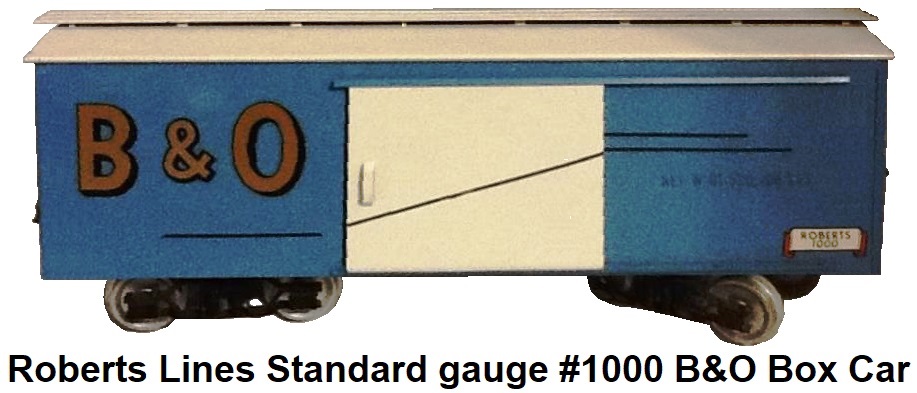 Rather than mimic features that other train manufacturers applied via lithography, the detail was kept to a minimum and evidenced in real hardware.
Corrugated steel catwalks, homespun brake wheels, and even real sprung trucks appeared on many of the early RL Products cars. The sprung trucks eventually gave way
to a Lionel #10 series type truck once Russ finally developed an elaborate series of dies with which to make them. Able now to make wheels like the early tinplate
manufacturers was Russ' greatest triumph and it was then that he reached his zenith in toy train manufacturing. More time went into the manufacture of these
products than any RL Products customers will ever realize. Russ retained the 'toy' flavor in these trains, leaving more elaborate scale modeling to the builders
who had such desires. Russ Roberts felt that if you only did half a job in trying to
achieve a scale appearance, then you have failed. It was better to offer a product that looked like a toy if that is what you were trying to sell. These freight cars
were inexpensive, and the operating enthusiasts could add their own detail to suit their own taste. That can be seen today, as many early pieces of Roberts' Lines
rolling stock appear at train meets or in on-line auctions exhibiting road names and paint schemes added by Standard gauge modelers.
Rather than mimic features that other train manufacturers applied via lithography, the detail was kept to a minimum and evidenced in real hardware.
Corrugated steel catwalks, homespun brake wheels, and even real sprung trucks appeared on many of the early RL Products cars. The sprung trucks eventually gave way
to a Lionel #10 series type truck once Russ finally developed an elaborate series of dies with which to make them. Able now to make wheels like the early tinplate
manufacturers was Russ' greatest triumph and it was then that he reached his zenith in toy train manufacturing. More time went into the manufacture of these
products than any RL Products customers will ever realize. Russ retained the 'toy' flavor in these trains, leaving more elaborate scale modeling to the builders
who had such desires. Russ Roberts felt that if you only did half a job in trying to
achieve a scale appearance, then you have failed. It was better to offer a product that looked like a toy if that is what you were trying to sell. These freight cars
were inexpensive, and the operating enthusiasts could add their own detail to suit their own taste. That can be seen today, as many early pieces of Roberts' Lines
rolling stock appear at train meets or in on-line auctions exhibiting road names and paint schemes added by Standard gauge modelers.
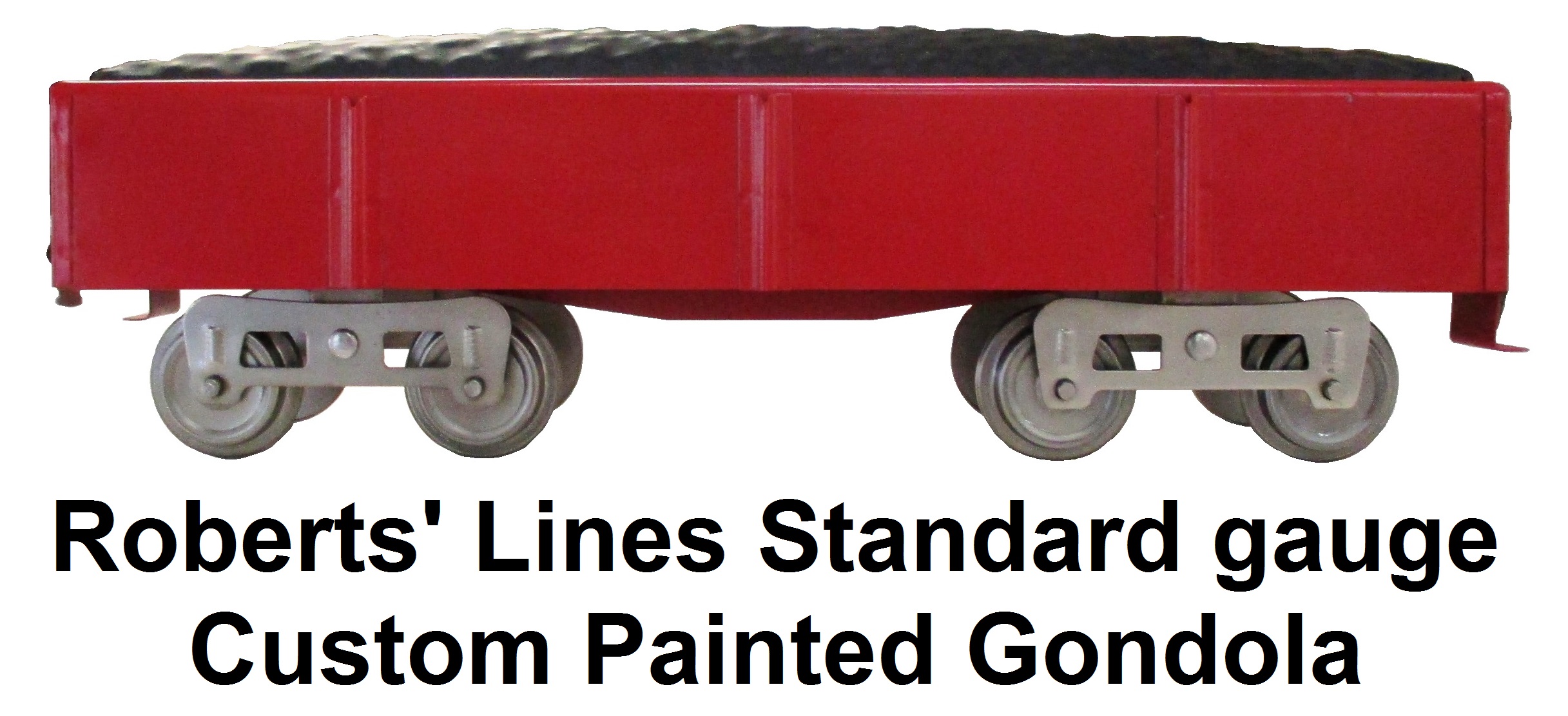
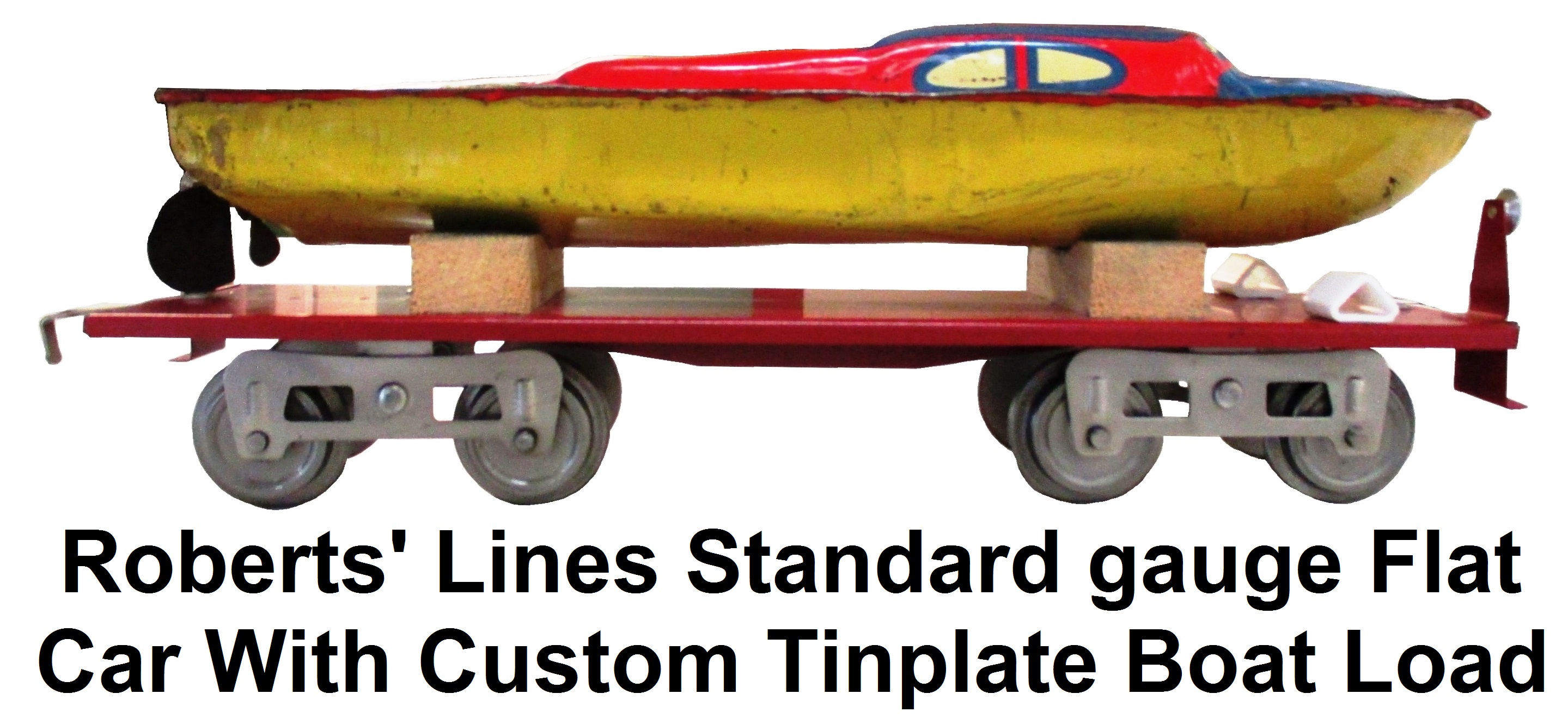
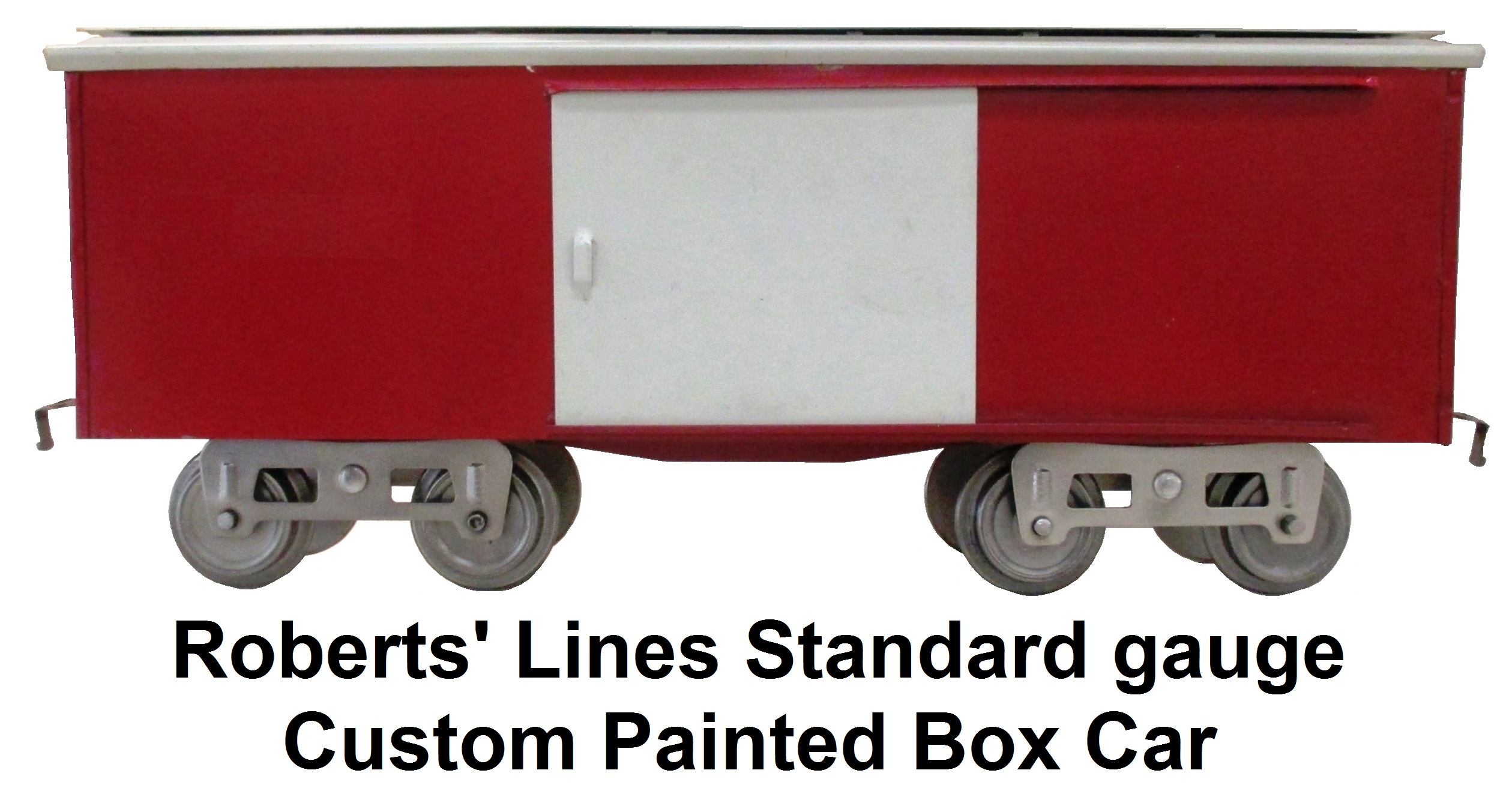
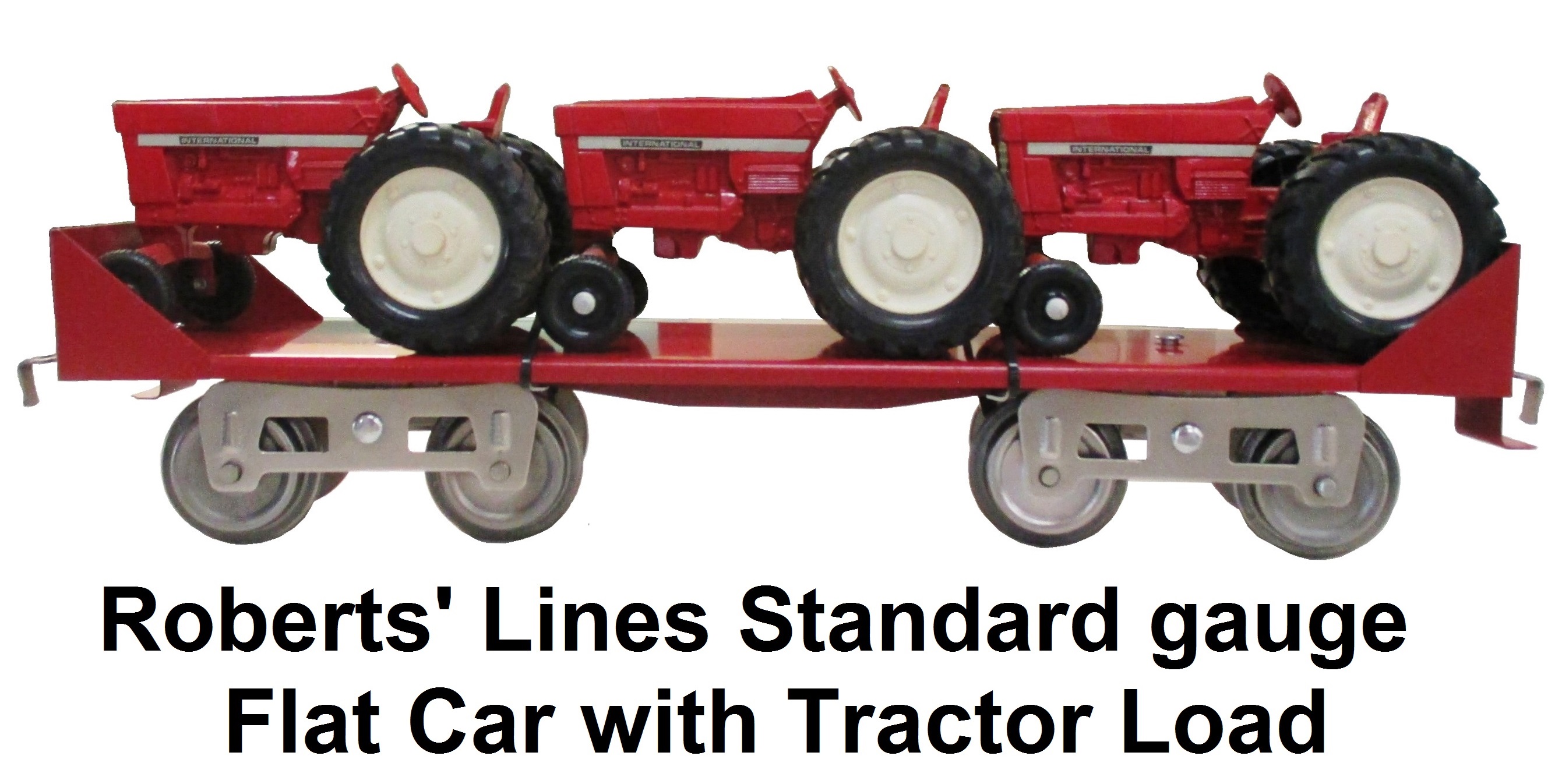
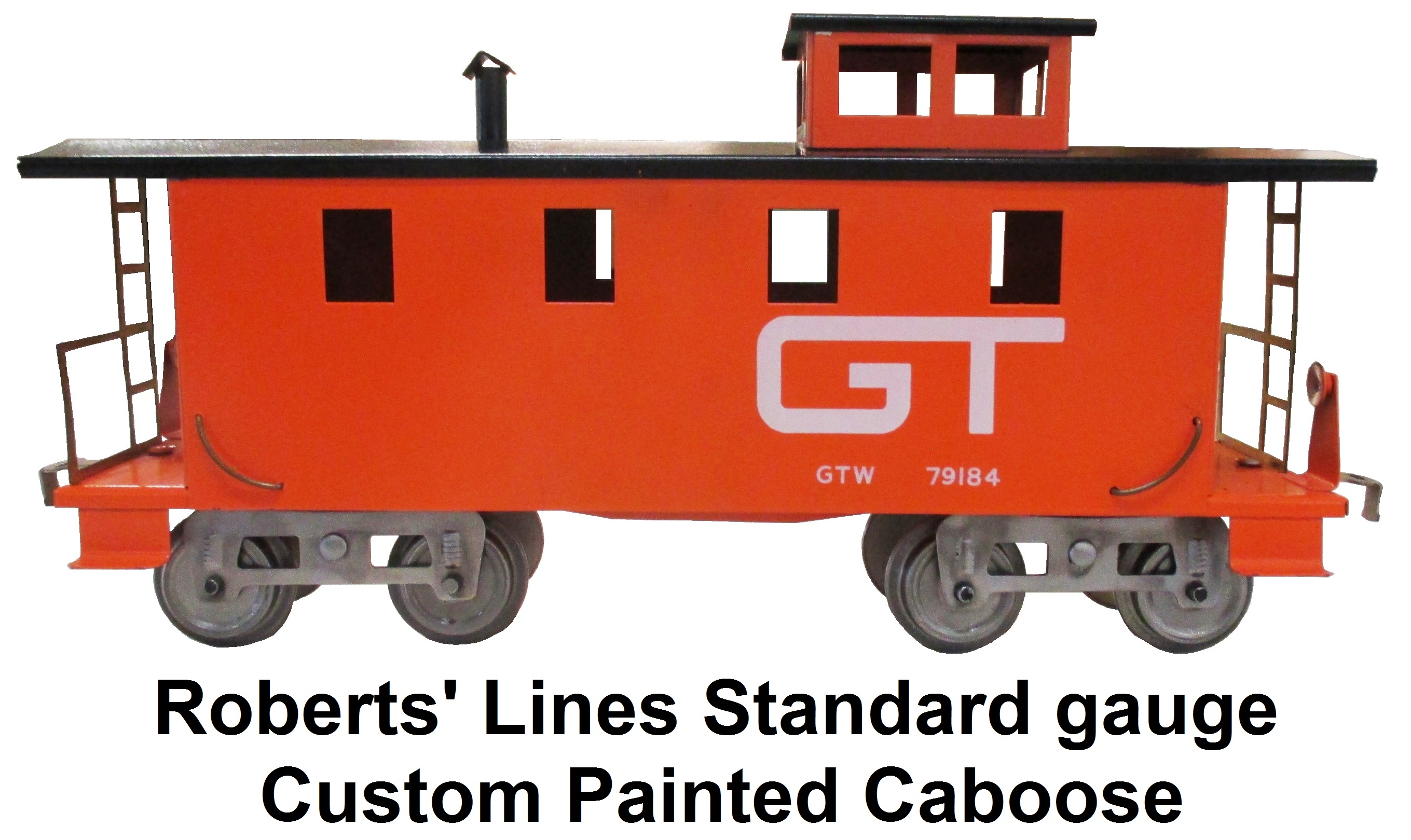
All regular production Roberts' Lines products were constructed of heavy, twenty-four
gauge sheet steel that was spot welded assembled for durability and extra strength. Truck and coupler components were quality
nickel-plated and additional trim and detail features were made of solid brass. Car bodies were double primed before receiving a baked-on enamel finish, both
inside and out. Colors were limited, but many special orders were filled for those who desired something unusual or custom.
 Roberts' Lines carried many different shapes and sizes of freight trains through the years, including some shorter
4-wheel 9 inch long freight cars. The smaller, 4-wheel series of freight cars were developed in the early 1970's, to satisfy operators and collectors with an
even smaller wallet. The gondola available in the 8-wheel set was replaced by a tank car in the 4-wheel set. The set also included a box car, flat car and caboose.
These cars used up only half of the hardest parts to
make, the wheels again, thus relieving Russ of much strain. Many of these freight car sets were sold: proof of his magic formula, and a noticeable desire from collectors for
inexpensive Standard gauge trains. The nice thing about the smaller cars was the compatibility with the smaller #8 or #10 Lionel locomotives. For someone
Roberts' Lines carried many different shapes and sizes of freight trains through the years, including some shorter
4-wheel 9 inch long freight cars. The smaller, 4-wheel series of freight cars were developed in the early 1970's, to satisfy operators and collectors with an
even smaller wallet. The gondola available in the 8-wheel set was replaced by a tank car in the 4-wheel set. The set also included a box car, flat car and caboose.
These cars used up only half of the hardest parts to
make, the wheels again, thus relieving Russ of much strain. Many of these freight car sets were sold: proof of his magic formula, and a noticeable desire from collectors for
inexpensive Standard gauge trains. The nice thing about the smaller cars was the compatibility with the smaller #8 or #10 Lionel locomotives. For someone
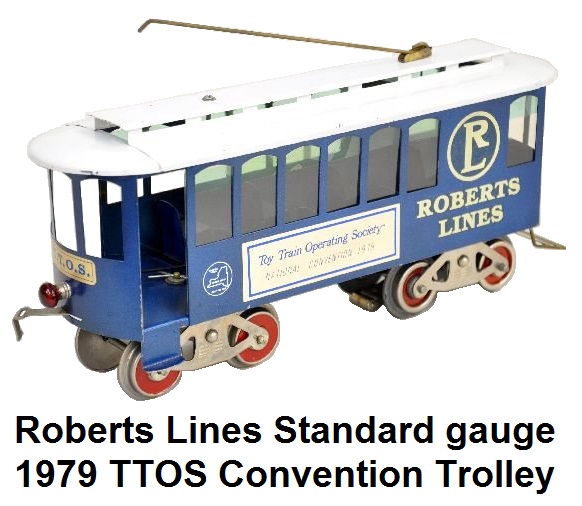 with a limited budget, these locomotives never looked right ahead of the large cars, and everyone can't afford a #408 or a #400E. Since the large scale series cars were
even larger than the #200 series Lionel cars, even some of the smaller steamers such as the #385 and the #1835 became dwarfed in proportion. It really required
a #402, #408, #392, or a #400E to respectably draw a consist of the large Roberts' Lines Standard gauge cars. The freight cars normally featured large Roberts'
Lines printed decals bearing the RL logo.
with a limited budget, these locomotives never looked right ahead of the large cars, and everyone can't afford a #408 or a #400E. Since the large scale series cars were
even larger than the #200 series Lionel cars, even some of the smaller steamers such as the #385 and the #1835 became dwarfed in proportion. It really required
a #402, #408, #392, or a #400E to respectably draw a consist of the large Roberts' Lines Standard gauge cars. The freight cars normally featured large Roberts'
Lines printed decals bearing the RL logo.
Robert H. Thon purchased Roberts'
Lines from Russ Roberts in the fall of 1978. Full attention was then devoted to the manufacture of an enclosed trolley, introduced only
shortly before Russ sold the business, and developed at Bob Thon's request for an unusual donation to a trolley museum by TTOS members. In 1980 Robert
Thon of Roberts' Lines showed a very limited production #100 Summertime trolley. The new version of
an old favorite included a brass luggage rack, trolley pole, and operating headlight and taillight, as well as
an optional 'under-the-floor' power truck. Much in the way of improvements over the initial design transpired after the purchase of RL, and
a very attractive #200 series two car trolley set was made available.
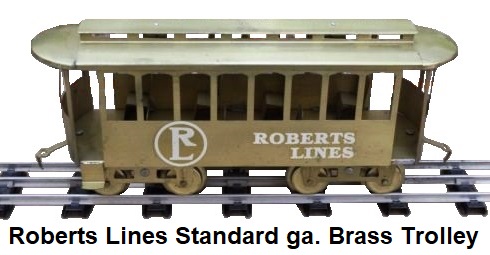 The trolley sets were initially introduced with an under-the-floor power truck, using a twelve volt D.C. automotive type motor and precision worm
gears. Development of a new #300 series Trolley Snow Sweeper forced the elimination of the powered trolley in the line. The newer Snow
Sweeper used a reproduction Bild-A-Loco motor obtained from Kris Model Trains, and exhibited full illumination inside and out. This
new product was shown at the October 1979 TCA meet at York, Pa. and shortly after went into full production. Roughly one hundred units per
year were planned to be available while production continued. Standard features on the non-powered trolleys included a brass luggage rack on the front
of the motor car, operable headlight and taillight on both cars (no third rail pick-up), and an authentic number-board exhibiting each trolley's
serial number, indicating the time it was manufactured. For an added charge,
the non-powered trolley could be made with third rail pick-up trucks, and fully operational exterior and interior illumination.
This feature accented the full complement of interior scaling. Window transparencies were also accented by the illumination,
and were provided in colors coordinated to the color of each set.
The trolley sets were initially introduced with an under-the-floor power truck, using a twelve volt D.C. automotive type motor and precision worm
gears. Development of a new #300 series Trolley Snow Sweeper forced the elimination of the powered trolley in the line. The newer Snow
Sweeper used a reproduction Bild-A-Loco motor obtained from Kris Model Trains, and exhibited full illumination inside and out. This
new product was shown at the October 1979 TCA meet at York, Pa. and shortly after went into full production. Roughly one hundred units per
year were planned to be available while production continued. Standard features on the non-powered trolleys included a brass luggage rack on the front
of the motor car, operable headlight and taillight on both cars (no third rail pick-up), and an authentic number-board exhibiting each trolley's
serial number, indicating the time it was manufactured. For an added charge,
the non-powered trolley could be made with third rail pick-up trucks, and fully operational exterior and interior illumination.
This feature accented the full complement of interior scaling. Window transparencies were also accented by the illumination,
and were provided in colors coordinated to the color of each set.
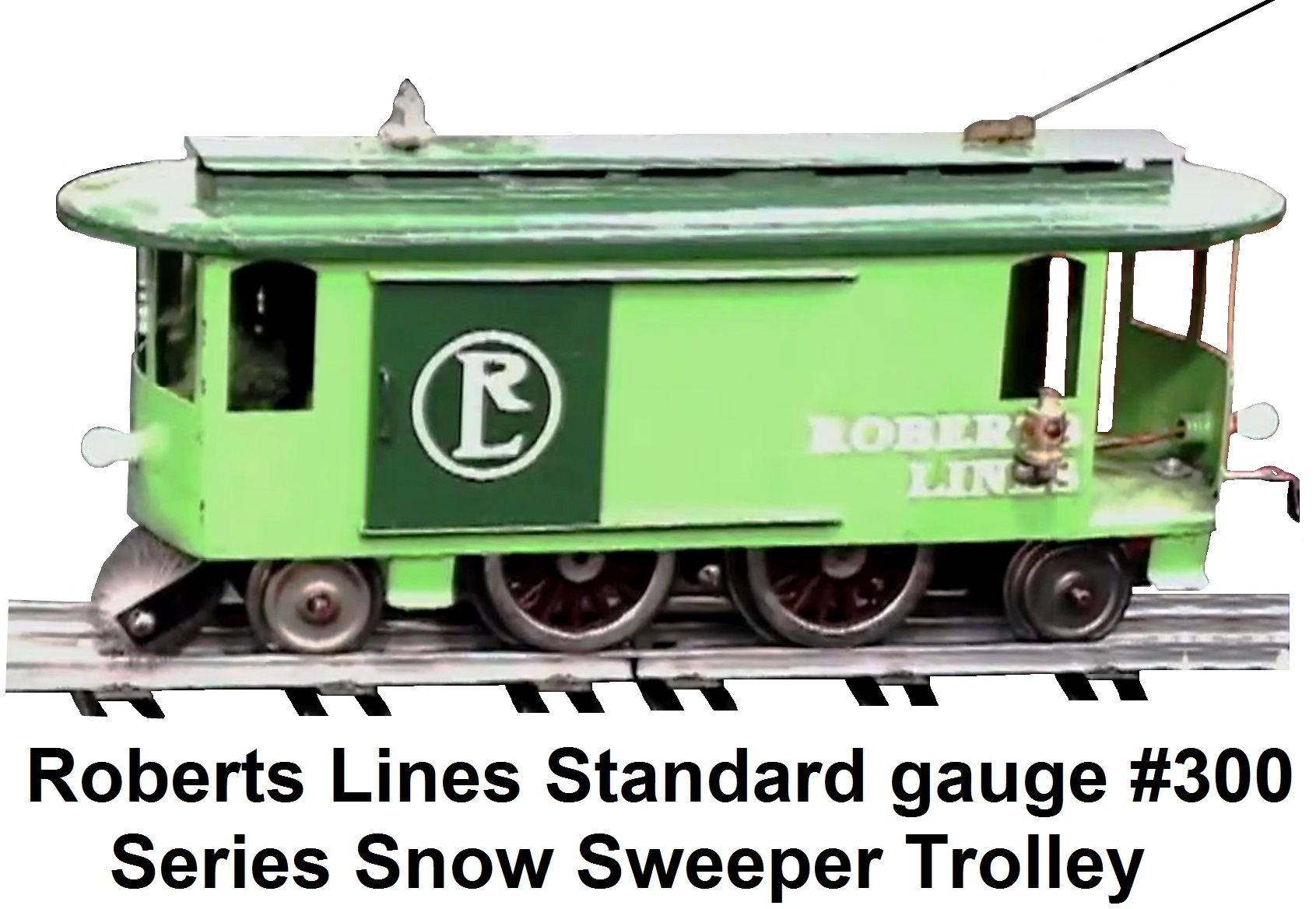 An unusual observation platform was made for a short time on the trailer-car of two car sets, similar to those seen on
many such interurban trolleys in operation in the 1900 to 1920 era. Collectors did not seem to pick up on this feature, so it was discontinued except by special
request. Collectors were known to have purchased sets of the trailer-cars including one with an open platform, and used them as passenger cars with a steam locomotive.
While offering the first #200 series trolleys, it became immediately apparent that there was still a significant market out there for more of the large, #10
series freight cars. Late in the fall of 1979, plans began to develop a very low volume re-introduction of these cars, and parts
were made for future production. This occurred at the same time an inventory of parts was being assembled to introduce the new #300 series Snow Sweeper.
The main emphasis remained on the Snow Sweeper. Another experiment by Bob Thon was a Roberts' Lines Standard gauge work trolley. A few of these were produced to test the market,
but there was little to no interest, and the item never went into regular production.
An unusual observation platform was made for a short time on the trailer-car of two car sets, similar to those seen on
many such interurban trolleys in operation in the 1900 to 1920 era. Collectors did not seem to pick up on this feature, so it was discontinued except by special
request. Collectors were known to have purchased sets of the trailer-cars including one with an open platform, and used them as passenger cars with a steam locomotive.
While offering the first #200 series trolleys, it became immediately apparent that there was still a significant market out there for more of the large, #10
series freight cars. Late in the fall of 1979, plans began to develop a very low volume re-introduction of these cars, and parts
were made for future production. This occurred at the same time an inventory of parts was being assembled to introduce the new #300 series Snow Sweeper.
The main emphasis remained on the Snow Sweeper. Another experiment by Bob Thon was a Roberts' Lines Standard gauge work trolley. A few of these were produced to test the market,
but there was little to no interest, and the item never went into regular production.
 Shortly after completing machining of parts for winter time manufacturing, a decision was made to hold up assembly on any
sizeable production of freight cars until a Roberts' Lines locomotive could be offered, built to proportion to compliment
the extra-large freight cars. Negotiations culminated with John Harmon and the Harmon Manufacturing
Co. was absorbed by Roberts' Lines. Harmon had initially created a 4-6-6-4 Union Pacific Big Boy Challenger loco in Standard
gauge in the late 1970's. Later he offered models of Pacific, Hudson, Atlantic and 10 Wheeler's using the same dies and
modified boiler castings from the Challenger tooling. The entire Harmon operation was moved from Huntington, NY
to Rochester, NY where the Roberts' Lines trains were made in the old site of the famed Penn Central RR car shops. It was
hoped that use of the Harmon tools would someday make it possible for Roberts' Lines to offer a wider range of Standard gauge
locomotives, including an 0-4-0 Dockside, Pacific, 10-wheelers, diamond stacks and Hudson configurations. Initially, the
4-6-6-4 and the Pacific were available on a special order basis. Build time was 6 to 9 months. These long locos are
articultated and intended to operate on regular Standard gauge track, but they would look better running on O-72 Standard
gauge track. The 4-6-6-4 loco with tender is 50" long and weighs 60 pounds. It features a copper boiler and aluminum castings.
It is powered by two 3-axle McCoy open frame traditional motors. Each of the motors is actually 2, having two armatures
driving the three axles. The loco is roughly 7/16" scale. Less than 120 of these have been built.
Shortly after completing machining of parts for winter time manufacturing, a decision was made to hold up assembly on any
sizeable production of freight cars until a Roberts' Lines locomotive could be offered, built to proportion to compliment
the extra-large freight cars. Negotiations culminated with John Harmon and the Harmon Manufacturing
Co. was absorbed by Roberts' Lines. Harmon had initially created a 4-6-6-4 Union Pacific Big Boy Challenger loco in Standard
gauge in the late 1970's. Later he offered models of Pacific, Hudson, Atlantic and 10 Wheeler's using the same dies and
modified boiler castings from the Challenger tooling. The entire Harmon operation was moved from Huntington, NY
to Rochester, NY where the Roberts' Lines trains were made in the old site of the famed Penn Central RR car shops. It was
hoped that use of the Harmon tools would someday make it possible for Roberts' Lines to offer a wider range of Standard gauge
locomotives, including an 0-4-0 Dockside, Pacific, 10-wheelers, diamond stacks and Hudson configurations. Initially, the
4-6-6-4 and the Pacific were available on a special order basis. Build time was 6 to 9 months. These long locos are
articultated and intended to operate on regular Standard gauge track, but they would look better running on O-72 Standard
gauge track. The 4-6-6-4 loco with tender is 50" long and weighs 60 pounds. It features a copper boiler and aluminum castings.
It is powered by two 3-axle McCoy open frame traditional motors. Each of the motors is actually 2, having two armatures
driving the three axles. The loco is roughly 7/16" scale. Less than 120 of these have been built.
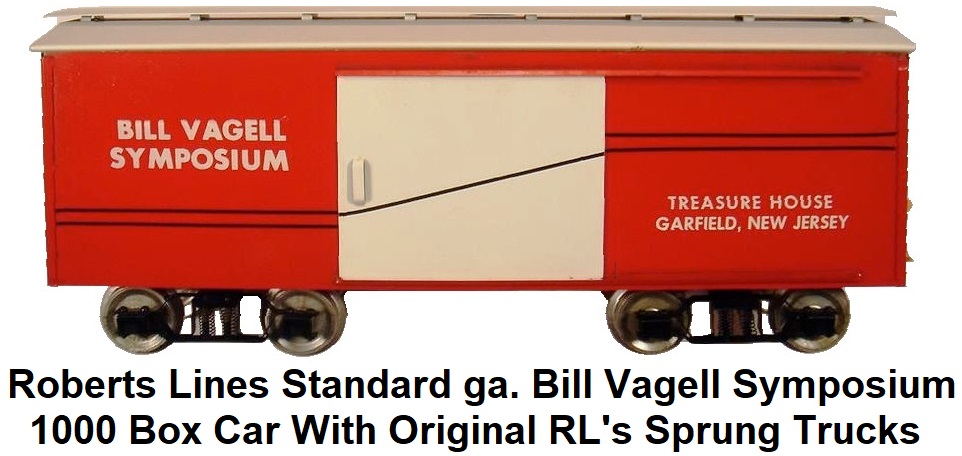 Over the years Bob Thon continued to evolve and improve the line. After Bob Thon took over Roberts' Lines, he issued a set
of very large cars on 4 x 14 inch frames. These Standard gauge freight cars were quite tall. The smoke stack and roof of the
cupola on the big Roberts' caboose are 7½ inches above the rails. The height limits the car from passing under the
portals of the Lionel #300 Hells Gate Bridge accessory, but the Lionel #17 caboose built before 1926 will not fit either.
Roberts' Lines freight cars are sometimes mis-identified as being made by McCoy or
Classic Model Trains, but they are actually much larger in size than anything ever built by those
manufacturers.
Over the years Bob Thon continued to evolve and improve the line. After Bob Thon took over Roberts' Lines, he issued a set
of very large cars on 4 x 14 inch frames. These Standard gauge freight cars were quite tall. The smoke stack and roof of the
cupola on the big Roberts' caboose are 7½ inches above the rails. The height limits the car from passing under the
portals of the Lionel #300 Hells Gate Bridge accessory, but the Lionel #17 caboose built before 1926 will not fit either.
Roberts' Lines freight cars are sometimes mis-identified as being made by McCoy or
Classic Model Trains, but they are actually much larger in size than anything ever built by those
manufacturers.
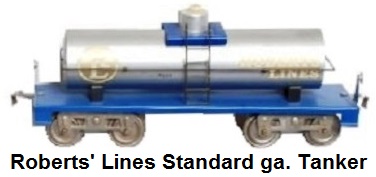 Bob Thon added an 8-wheel tank car to the line. There were very few of these Roberts' Lines tank cars made however as it was
a difficult, time consuming, and an expensive car for a small manufacturer to make. Roberts' Lines tank cars were always
painted blue and silver and are hard to find. Two of the Roberts' Lines cars, the gondola and the hopper, were originally
fabricated using tooling created by Red Forney. The gondola and hopper bodies were supplied by Duane
Eberhart, of Lewisburg, PA after he acquired Forney's dies from his widow Janet. The Eberhart produced gondola is easily
identified as it has only three ribs on a side and flat ends instead of the Forney dreadnaught ends. All of the Roberts'
freights were mounted on Roberts Lines frames and reproductions of large Lionel #10 series Standard gauge trucks. Bob
Thon offered these cars with heralds of actual railroads or with the Roberts' Lines 'RL' logo. A batch of hoppers with the
Roberts' Lines logo sold out so quickly that Bob had none left for himself. He and Bob Hendrich later made nine extra hopper
cars using original tooling created by Glenn Gerhard, founder of Glenn Toy Trains.
Bob Thon added an 8-wheel tank car to the line. There were very few of these Roberts' Lines tank cars made however as it was
a difficult, time consuming, and an expensive car for a small manufacturer to make. Roberts' Lines tank cars were always
painted blue and silver and are hard to find. Two of the Roberts' Lines cars, the gondola and the hopper, were originally
fabricated using tooling created by Red Forney. The gondola and hopper bodies were supplied by Duane
Eberhart, of Lewisburg, PA after he acquired Forney's dies from his widow Janet. The Eberhart produced gondola is easily
identified as it has only three ribs on a side and flat ends instead of the Forney dreadnaught ends. All of the Roberts'
freights were mounted on Roberts Lines frames and reproductions of large Lionel #10 series Standard gauge trucks. Bob
Thon offered these cars with heralds of actual railroads or with the Roberts' Lines 'RL' logo. A batch of hoppers with the
Roberts' Lines logo sold out so quickly that Bob had none left for himself. He and Bob Hendrich later made nine extra hopper
cars using original tooling created by Glenn Gerhard, founder of Glenn Toy Trains.
One of the most unusual items Bob Thon designed was a Standard gauge shorty 5½ inch long outhouse on wheels freight
wagon, nicknamed 'Johnnie on the Spot.' It was a big hit as a conversation piece and became the most popular item Roberts'
Lines sold. By special request, Bob Thon also revitalized and put together several of the shorty Standard gauge freight cars
originally designed and produced in the 1970's by Russ Roberts. These cars were built for freinds and for Bob's fellow
national officers of the Toy Train Operating Society.

Many of the Roberts' Lines freight cars often show up in G gauge 1:32 scale (sometimes referred to as
gauge one) layouts and collections. Bob Thon often fitted the freight cars with G scale trucks instead of Standard gauge
trucks and sold them as G scale for the garden train crowd. This was a niche market that created an alternative outlet for
the large freight car products. In the 1980's Roberts' Lines sold re-cast Randall heavyweight Pullman passenger cars in 1 gauge
(for G scale track operation) along with a 1929 Randall Hudson made from the original castings. The Randall cars were
made of cast aluminum and were first produced in the late 1920's and 1930's by Thomas Randall of Chicagoland. The line
consisted of the Hudson loco and 4 passenger cars. These trains were roughly scaled at ⅜" and advertised to run
on Standard or K gauge track. Relic of Evanston, Il produced the Randall cars in conjunction with Thomas Randall's son in the
late 1970's. They continued to supply castings for the 4 different cars in long (28") and short (21") versions with both
closed or open ends, for Bob Thon of Roberts' Lines through the 1990's when the molds finally wore out. The engine was
never recast as the original mold was lost or destroyed sometime in the 1930's, therefore very few engines were ever cast.
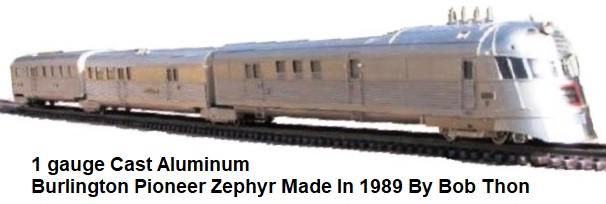 Bob Thon also marketed a Roberts' Lines 1 gauge aluminum bodied Chicago, Burlington & Quincy Pioneer
Zephyr 3 car set in 1989. These were manufactured by FM Models Precision in Seoul, Korea from Bob's designs. The power car
featured two large Pittman motors with fly-wheels. These were connected to a black gear box
with a brass u-joint. The Zephyr was geared to run at scale speed of 80 mph, and designed to run on 8’ diameter curves
(15 foot or greater was recommended). Only 100 of these were ever made and they sold out very quickly.
Bob Thon also marketed a Roberts' Lines 1 gauge aluminum bodied Chicago, Burlington & Quincy Pioneer
Zephyr 3 car set in 1989. These were manufactured by FM Models Precision in Seoul, Korea from Bob's designs. The power car
featured two large Pittman motors with fly-wheels. These were connected to a black gear box
with a brass u-joint. The Zephyr was geared to run at scale speed of 80 mph, and designed to run on 8’ diameter curves
(15 foot or greater was recommended). Only 100 of these were ever made and they sold out very quickly.
In the 1980's Bob Thon of Roberts Lines started building two tinplate Standard gauge McKeen Motor cars with trailers.
Bob went to work and created four car sides out of steel. However, the project came to a halt when Bob decided to market
the McKeen cars being manufactured by Dick Mayer of Rich-Art at that time instead of making his
own models. Bob abandoned his original prototypes, and hung his four unfinished car sides up on the shop wall and that's
where they stayed until early in 2010. He decided to finally complete his version almost 25 years later. After Glenn C.
Gerhard's death in 1995, Bob Thon acquired the remaining tooling and parts from his Glenn Toy Trains.
Glenn Toy Trains was known for having produced about 70 cast aluminum Standard gauge 0-6-0 steam outline locos and 300 sheet
metal Alco F1A and B units. The purchase included a handful of the left over 0-6-0 castings and subsequently Bob was able to
build a few more that he offered to collectors in kit form through 2017.

Bob Thon also sold products made by other small manufacturers. This included the Transportation Milestones Super Chief
Santa Fe F-3 diesel locomotive and extruded aluminum BUDD passenger car sets made by Robert DeHanes in both Standard and G
gauges. Bob also marketed the big 29 inch long Gold Standard's GG-1 electric loco developed by Robert
Hendrich in the late 1970's. Before retiring from a long and successful working career to concentrate on his love of model
train building, Bob was a design engineer for Xerox and also during his working career was an electrical technician
for the Mercury and Apollo Space Programs. Thon has had his model trains exhibited in the Medina Railroad Museum, Medina,
N.Y. and the Museum of Science and Industry, Chicago as well as in the countries of Japan and France.
Roberts' Lines, PO Box 96, East Rochester, NY 14445-0096, (315)986-1365, roblines@earthlink.net
Back To Top of Page

